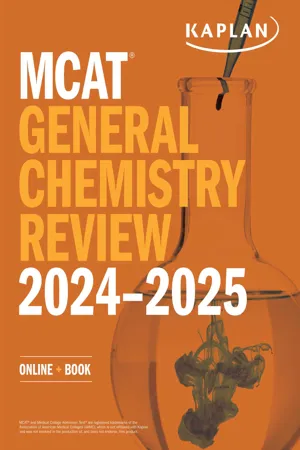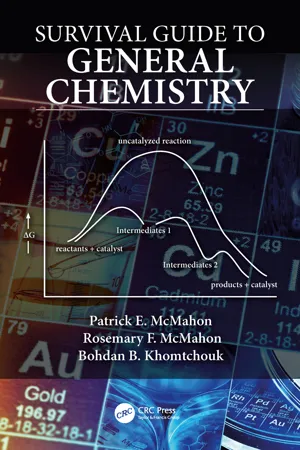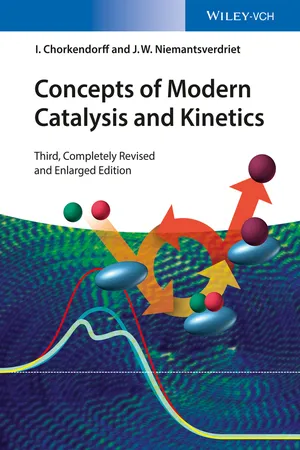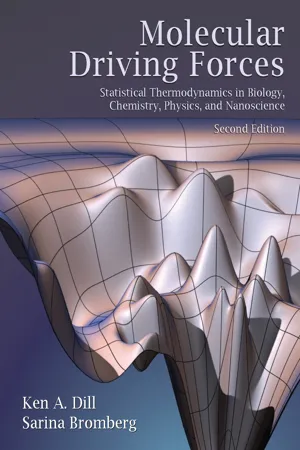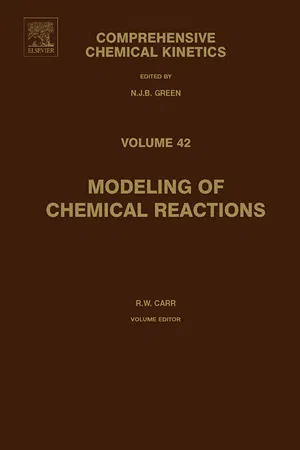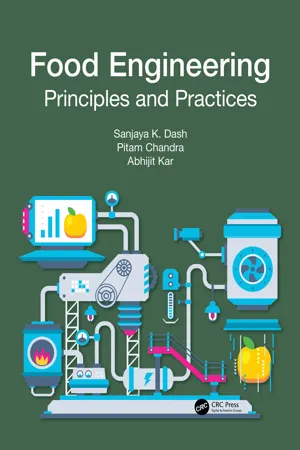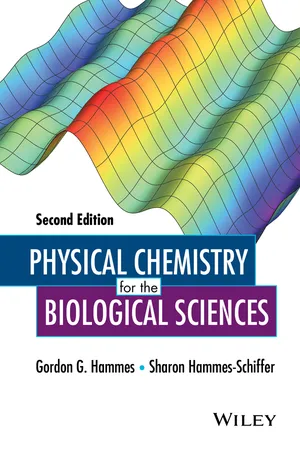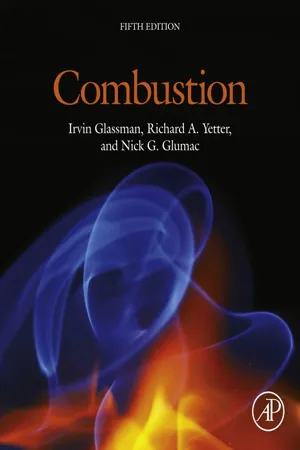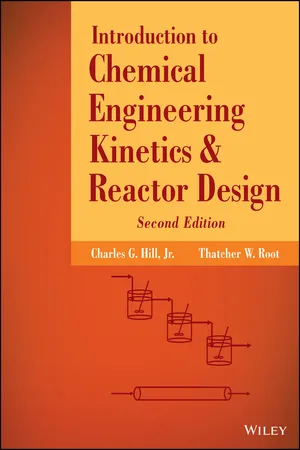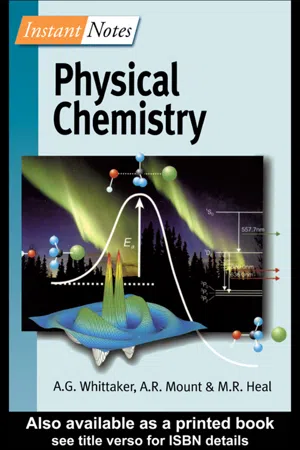Chemistry
Kinetics
Kinetics refers to the study of the rates of chemical reactions and the factors that influence these rates. It involves examining the speed at which reactants are consumed and products are formed. Kinetics also explores the mechanisms by which reactions occur, providing insights into the underlying processes that drive chemical transformations.
Written by Perlego with AI-assistance
Related key terms
Related key terms
1 of 4
Related key terms
1 of 3
11 Key excerpts on "Kinetics"
- No longer available |Learn more
MCAT General Chemistry Review 2024-2025
Online + Book
- (Author)
- 2023(Publication Date)
- Kaplan Test Prep(Publisher)
CHAPTER 5CHEMICAL Kinetics
In This Chapter
5.1 Chemical KineticsReaction Mechanisms Molecular Basis of Chemical Reactions Factors Affecting Reaction RateDefinition of Rate Determination of Rate Law Reaction Orders5.2 Reaction RatesConcept SummaryCHAPTER PROFILE
The content in this chapter should be relevant to about 11% of all questions about general chemistry on the MCAT. This chapter covers material from the following AAMC content categories:1A: Structure and function of proteins and their constituent amino acids5E: Principles of chemical thermodynamics and KineticsIntroduction
The following chapters focus on two primary topics: chemical Kinetics and chemical equilibrium. As the term suggests, chemical Kinetics is the study of reaction rates, the effects of reaction conditions on these rates, and the mechanisms implied by such observations. We start with Kinetics because the molecular basis of reactions provides us with a framework of reaction chemistry. Following this, we will explore the equilibria of these reactions, which are related to—but distinct from—the Kinetics of the reactions.You may already have a fairly good understanding of equilibrium and the differences between spontaneous and nonspontaneous reactions. For instance, the utilization of ATP in the body is a spontaneous reaction that can be used to provide thermochemical energy for other reactions. While the equilibrium tells us that ATP will favor dissociation, it tells us nothing about its rate of dissociation. And, in fact, various conditions in the body can alter the rate at which ATP is synthesized and utilized for energy—primarily temperature. Some of the symptoms of hyper- and hypothermia are related to changes in metabolism caused by changes in temperature and reaction Kinetics. - eBook - ePub
- Patrick E. McMahon, Rosemary McMahon, Bohdan Khomtchouk(Authors)
- 2019(Publication Date)
- CRC Press(Publisher)
22 Kinetics Part 1 Rate Laws, Rate Equations, and an Introduction to Reaction MechanismsI GENERAL CONCEPT OF Kinetics Kinetics is the study of rates of complete reactions by mathematical and experimental analysis to determine reaction mechanisms. A reaction mechanism is a description of the bonding events that occur along the pathway reactants follow to form products.Rates of reaction are measured by quantifying concentration changes, either the disappearance of a reactant or the appearance of a product as a function of time (t):rate (r ) = − Δ [ reactant ] / Δt or rate (r ) = + Δ [ product ] / ΔtRates of reactions are generally proportional to the concentration of one or more of the reactants raised to a specific power (exponent); This relationship is termed the rate expression or rate law:rate ( r ) = k[ reactant 1 ]X. . . .[ reactant 2 ]YThe constant in the expression is called the rate constant, k; the numerical values of the exponents x, y, and so on, are called the reactant orders. For example, if x = 2 in the above general expression, the reaction is “second order in reactant 1.”The sum of all the exponents x + y… is called the reaction order. For example, if x = 2 and y = 1 in the above general expression, the reaction would be described as a “third-order reaction.” The values of k, x, y… depend on the reaction mechanism.ADDITIONAL VARIABLES AFFECTING REACTION RATESRates are inversely proportional to the energy barriers that prevent a specific reaction or reaction step from occurring; this barrier is called the activation energy, or activation barrier, for the reaction or step (general symbol: Ea).The activation energy, Ea, represents the energy that must be added to reactants to allow bonding changes to occur.A reaction rate will increase as the activation energy (barrier) decreases. Ea is a path function and does not depend directly on the value of the energy change for the complete reaction. The specific Ea, which is most important for a complete reaction containing many steps, depends on the reaction mechanism. - eBook - ePub
- Jeffrey Gaffney, Nancy Marley(Authors)
- 2017(Publication Date)
- Elsevier(Publisher)
reaction rate , defined as the change in concentration as a function of time, can often vary widely for different chemical reactions. While chemical thermodynamics predicts if a chemical reaction will occur, chemical Kinetics predicts how fast a reaction will occur. So, it can be said that thermodynamics guides while Kinetics decides if a reaction will occur in a time frame that will be useful. In addition, by determining the effects of temperature and concentrations on the reaction rate, chemical Kinetics can provide a means of controlling and optimizing the speed of a chemical reaction.Chemical Kinetics uses an experimental approach to study the rates and mechanisms of chemical reactions. It accomplishes this through careful measurements of the reactant and/or product concentrations as a function of time. For the general chemical reaction between reactants A and B producing the products C and D;a A + b B → c C + d Dthe changes in the concentrations of [A], [B], [C], and [D] are measured as a function of time and are described mathematically in the form of a derivative of each concentration with respect to time. The reactants are represented as negative derivatives because their concentrations decrease with time and the products are represented as positive derivatives because their concentrations increase with time:Reactant concentration change = − d A / dt and − d B / dtProduct concentration change = d C / dt and d D / dtThe change in the concentrations between the reactants A and B and the products C and D will depend upon the stoichiometric coefficients: a , b , c , and d . For the simple case of a = b = c = d - eBook - ePub
- I. Chorkendorff, J. W. Niemantsverdriet(Authors)
- 2017(Publication Date)
- Wiley-VCH(Publisher)
ab initio theoretical chemistry, and transition state theory. It is at this level that we can learn what determines whether a chemical reaction is feasible.In practical situations, we are not interested in the single event but in what happens in a large ensemble of molecules. We therefore have to average over all possibilities, that is, over all energies and coordinates of the reacting molecules. This is what Kinetics is about. Temperature is the parameter that suitably describes the average energy content of the molecules participating in the reaction. Thermodynamics determines the changes in free energy that accompany a reaction and sets limits to the fraction of molecules that can be converted. Thus, Kinetics describes the behavior of large ensembles of molecules during a reaction.2.2 The Rate Equation and Power Rate Laws
Suppose a reaction between molecules A and B gives product molecules C and D according to the reaction equation(2.1)with forward and backward rate constants, k+ and k− , and stoichiometric coefficients νa , νb , νc , and νd . The rate of reaction is defined as the rate of disappearance of the reactants, or the rate of formation of products:(2.2)where [X] stands for the concentration of component X. If the reaction occurs in the gas phase, we may replace the concentrations by partial pressures: [X] ∝ pX /p◦ , where p◦ is the reference pressure (p◦ = 1 bar).(2.3)Very often, we will not include the reference pressure, p◦ , but implicitly assume that p represents a relative quantity.A reaction is elementary if it occurs in a single step that cannot be divided into any further substeps and proceeds exactly as expressed by the reaction equation (Eq. (2.1) ). For an elementary step, the rate equals(2.4)in which k+ and k− - eBook - ePub
Molecular Driving Forces
Statistical Thermodynamics in Biology, Chemistry, Physics, and Nanoscience
- Ken Dill, Sarina Bromberg(Authors)
- 2010(Publication Date)
- Garland Science(Publisher)
19 Chemical Kinetics & Transition States Chemical Reaction Rates Depend on TemperatureNow, we focus on the Kinetics of chemical reactions. To predict how the rate of a chemical reaction depends on its molecular structures, you can use the same statistical thermodynamics approach that we used in Chapter 13 to model equilibria. Chemical reactions typically speed up more strongly with temperature than physical processes do. To understand this, you need one additional concept: the transition state or activation barrier.The Mass Action Laws Describe Mechanisms in Chemical KineticsConsider a chemical reaction in which a product P is produced from reactants A, B, and C, with stoichiometric coefficients a, b, and c:a A + b B + c C → P .(19.1) In general, the reaction rate depends on the concentrations of the reactants, the temperature and pressure, and the coefficients a, b, and c. Experiments often measure how reaction rates depend on the concentrations of the reactants. Such experiments can provide valuable information about the mechanism of the reaction.The kinetic law of mass action, first developed by CM Guldberg and P Waage in 1864, says that reaction rates should depend on stoichiometry in the same way that equilibrium constants do. According to this law, the initial rate of product formation, d[P]/dt for the reaction in Equation (19.1) , depends on the reactant concentrations:=d[ P ]d tk f[ A ]a[ B ]b,[ C ]c(19.2) where kf is the rate coefficient for the forward reaction. However, kinetic mechanisms often do not follow the thermodynamic stoichiometries. If a reaction is a single step, called an elementary reaction, then such expressions apply. The main types of elementary reactions are unimolecular decay of a molecule (a = 1, b = c = 0) or a bimolecular reaction when two molecules come together (a = b = 1, c = 0). However, chemical reactions typically involve multiple steps and kinetic intermediate states. For such non-elementary reactions, you cannot express the rate equation in such simple stoichiometric terms. At present, rate laws can only be determined from experiments. We do not address reaction mechanisms here; they are described in chemical Kinetics textbooks such as [1 , 2 - eBook - ePub
- R.W. Carr(Author)
- 2007(Publication Date)
- Elsevier Science(Publisher)
Chapter 3 Elements of Chemical KineticsRobert W. CarrAbstractPublisher Summary
This chapter focuses on the definitions and underlying principles of chemical Kinetics and provides an introduction to the theory of elementary reactions as well as discussing unimolecular reactions. The elementary concepts discussed are stoichiometry, the reaction rate of conversion of reactants into products, the rate expression, elementary reactions, state-to-state Kinetics, the temperature dependence of the rate coefficient, kinetic data, mechanism of reaction, the steady-state approximation, and microscopic reversibility and detailed balance. The potential energy of interaction among atoms, molecules, ions, and free radicals plays a central role in determining the chemical reactivity of these species. The Born–Oppenheimer approximation, long-range interactions, short-range repulsive forces, bonding interactions, and potential energy surfaces are discussed. The chapter also discusses the bimolecular-reaction rate theory, simple collision theory (SCT), bimolecular collision dynamics, ion–ion reactions, bimolecular association of free radicals, classical trajectory calculations, transition state theory (TST), tests of TST, microcanonical TST, variational TST, the transmission coefficient, quantum tunneling, electronically non-adiabatic reactions, and thermolecular reactions.1 Introduction
This chapter is a primer on chemical Kinetics. It should be useful to anyone who finds it desirable or necessary to get started on modeling a complex chemical reaction, and whose background does not include training in Kinetics, or who wishes to brush up. Although the material in this chapter can be found in standard textbooks on Kinetics, several of which are referenced below, it was thought that having a basic overview of the subject readily at hand would be a welcome convenience. Consulting other texts will be necessary to fill in many of the details. The chapter is divided into two parts. The first part is concerned with definitions and underlying principles of chemical Kinetics; the second part provides an introduction to the theory of elementary reactions, with the exception of unimolecular reactions which are covered in Chapter 4. - eBook - ePub
Food Engineering
Principles and Practices
- Sanjaya K. Dash, Pitam Chandra, Abhijit Kar(Authors)
- 2023(Publication Date)
- CRC Press(Publisher)
4 Reaction Kinetics
DOI: 10.1201/9781003285076-5The concept of the rate of reaction or reaction speed is important in food processing operations. Most of the reactions occurring in food involve conversion of one component to another. A common example is conversion of sucrose to glucose and fructose. Many forms of spoilage of food and degradation of nutrients occur due to chemical reactions within the food. Hence, a knowledge of the rate of reaction is required to decide the processing parameters or to determine the potential shelf life of any food.4.1 Chemical Kinetics and Order of Reaction
The process of chemical reactions occurring in food can be explained like any other chemical reaction. Chemical Kinetics is the component of physical chemistry that studies reaction rates. The energy level of the reactants (reacting substances) has to be first increased to a reasonable level for the reaction to start. This energy, which must be supplied to the reactants before the reaction can start, is called the activation energy. Activation energy is the threshold value acquired by the reactant(s) before reaching the transition state. The reaction then begins and continues either in a forward or in a backward direction.The reaction rate or speed of reaction can be slow, as in the browning of a cut apple or the rusting of a metal, or fast, as oxygen reacts with magnesium to form magnesium oxide (Mg + O → MgO) or the Maillard reaction, which is a non-enzymatic reaction occurring between sugars and proteins, which lead to browning of some foods as they are heated. The rate of a reaction can be simply expressed as the rate of change in concentration of a reactant. It may also be given as the rate of generation of a new substance. Suppose component A is converted to component B in a particular reaction. The reaction rate can be given as the rate of change in concentration of the component A or B. The concentration change can, thus, be given in mol.dm−3 . s−1 (or mol. l−1 .s−1 ), i.e., “moles per cubic decimeter per second” or “moles per liter per second.” If B is a gas, then the rate during the reaction can be expressed as the volume given off per unit time at any particular time (say in cm3 s−1 - eBook - ePub
- Gordon G. Hammes, Sharon Hammes-Schiffer(Authors)
- 2015(Publication Date)
- Wiley(Publisher)
CHEMICAL KineticsPassage contains an image
Chapter 5 Principles of Chemical Kinetics
5.1 INTRODUCTION
Thermodynamics tells us what changes in state can occur, that is, the relative stability of states. For chemical reactions, it tells us what reactions can occur spontaneously. However, thermodynamics does not tell us the time scale for changes in state or how the changes in state occur; it is concerned only with the differences in the initial and final states. In terms of chemical reactions, it does not tell us how the reaction occurs, in other words, the molecular interactions that take place as a reaction occurs. For biological reactions, the rates are critical for the survival of the organism, and a primary interest of modern biology is the molecular events that lead to reaction. The study of the rates and mechanisms of chemical reactions is the domain of chemical Kinetics. Thermodynamics provides no intrinsic information about mechanisms.Many examples exist with regard to the importance of the time scale for chemical reactions. For those of you having diamond jewelry, you may be unhappy to know that the most stable state of carbon under standard conditions is graphite. So as you read this, your diamond is turning to graphite, but fortunately the time scale for this conversion is many hundreds of years. If graphite is more stable, why were diamonds formed? The answer is that the formation of diamonds did not occur under standard conditions: it is well known that at very high temperatures and pressures, graphite can be converted to diamond. In the biological realm, one of the most critical reactions is the hydrolysis of ATP to ADP and Pi . Thermodynamics tells us that the equilibrium lies far toward ADP and Pi - eBook - ePub
- Irvin Glassman, Richard A. Yetter, Nick G. Glumac(Authors)
- 2014(Publication Date)
- Academic Press(Publisher)
Chapter 2Chemical Kinetics
Abstract
Chemical reaction types, reaction orders, and the law of mass action that describes the rates of reactions are presented. The Arrhenius rate constant expression and methods for analysis of rate constants, including transition state and recombination rate theories, are discussed as well as the effects of pressure and temperature. Chain reactions are introduced, and steady-state and partial equilibrium approximations are applied for their analysis. The mathematical formalism for large reaction mechanisms is illustrated through the development of the governing equations for coupled thermal and chemical reacting systems without mass diffusion. Finally, sensitivity and rate-of-production analyses are discussed for mechanism analysis as well as methods for mechanism reduction.Keywords
Arrhenius rate constant; Chemical reactions; Partial equilibrium and steady-state assumptions; Pressure-dependent reactions; Rate-of-production analysis; Reaction rates; Sensitivity analysis; Transition state theory2.1. Introduction
Flames will propagate through only those chemical mixtures that are capable of reacting quickly enough to be considered explosive. Indeed, the expression “explosive” essentially specifies very rapid reaction. From the standpoint of combustion, the interest in chemical kinetic phenomena has generally focused on the conditions under which chemical systems undergo explosive reaction. Recently, however, great interest has developed in the rates and mechanisms of steady (nonexplosive) chemical reactions, since most of the known complex pollutants form in zones of steady, usually lower-temperature, reactions during, and even after, the combustion process. These essential features of chemical Kinetics, which occur frequently in combustion phenomena, are reviewed in this chapter. For a more detailed understanding of any of these aspects and a thorough coverage of the subject, refer to any of the books on pure chemical Kinetics, such as those listed in Refs [1 ,2 - Charles G. Hill, Thatcher W. Root(Authors)
- 2014(Publication Date)
- Wiley(Publisher)
Chapter 3 Basic Concepts in Chemical Kinetics: Determination of the Reaction Rate Expression3.0 Introduction
Key concepts employed by chemists and chemical engineers in the acquisition, analysis, and interpretation of kinetic data are presented in this chapter. The focus is on determination of empirical rate expressions that can subsequently be utilized in the design of chemical reactors. To begin, we find it convenient to approach the concept of reaction rate by considering a closed isothermal constant pressure homogeneous system of uniform composition in which a single chemical reaction is taking place. In such a system the rate of the chemical reaction (r) is defined as3.0.1where V is the system volume, ξ the extent of reaction, and t is time. Several facts about this definition should be noted.- The rate is defined as an intensive variable. Note that the reciprocal of the system volume is outside the derivative term. This consideration is important in treating variable volume systems.
- The definition is independent of any particular reactant or product species.
- Because the reaction rate almost invariably changes with time, it is necessary to use the time derivative to express the instantaneous rate of reaction.
Many sets of units may be used to measure reaction rates. Because the extent of reaction is expressed in terms of moles, the reaction rate has the units of moles transformed per unit time per unit volume. The majority of the data reported in the literature are expressed in some form of the metric system of units [e.g., mol/(L · s) or molecules/(cm3- eBook - ePub
- Gavin Whittaker, Andy Mount, Matthew Heal(Authors)
- 2000(Publication Date)
- Taylor & Francis(Publisher)
F1 EMPIRICAL APPROACHES TO KineticsKey Notes
Experimental methods Experimental methods in Kinetics measure change in the composition of a reaction mixture with time, either continuously as the reaction progresses, or at fixed intervals after the reactants have come together. The techniques applied vary depending on the timescale of the reaction and the chemical species under study. Additional kinetic information is obtained by varying experimental parameters such as the initial concentration of reactant(s) or the temperature of the mixture. Rate of reaction The instantaneous rate of reaction for a species is the rate of change of concentration with time of that species at a particular instant during the reaction. Units of reaction rate always have dimensions of concentration time−1 . Rate law The rate law is the empirically determined mathematical relationship describing the observed rate of reaction in terms of the concentrations of the species involved in the reaction. Rate laws do not necessarily fit the simple stoichiometry of a balanced chemical reaction but may be the consequence of a more complex underlying mechanism to the observed reaction. Rate constants Rate constants are the constants of proportionality within the empirical rate law linking rate of reaction and concentration of species involved in the reaction. The units of rate constants are particular to the rate law and can be derived by dimensional analysis. Rate constants usually vary with temperature. Order of reaction If the rate law for a reaction can be written in the form, rate ∝ [A]α [B]βthen the reaction is classified as α -order in A, β -order in B,…and as (α+β+…) -order overall. The exponents do not have to be integers, and for complex rate laws, the order may not be a definable quantity.Molecularity The molecularity of a reaction is the number of molecules which come together to react and is independent of the order of a reaction. In a unimolecular reaction a single molecule breaks apart or rearranges its constituent atoms. A bimolecular reaction involves two atoms or molecules.
Index pages curate the most relevant extracts from our library of academic textbooks. They’ve been created using an in-house natural language model (NLM), each adding context and meaning to key research topics.
Explore more topic indexes
Explore more topic indexes
1 of 6
Explore more topic indexes
1 of 4
